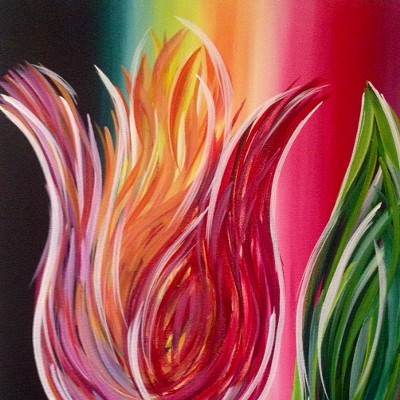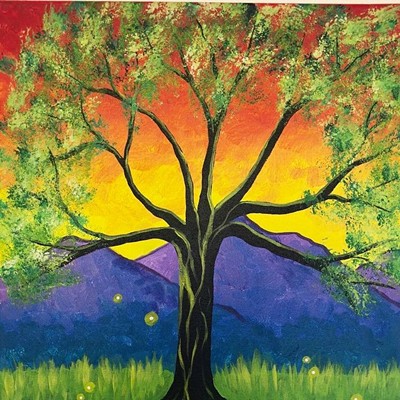Made of oil and canvas and the kind of battered linoleum that beleaguered farmwives once vainly tried to get clean, her abstracted paintings suggested a western landscape of drought and desperation. Rusted buckets and water troughs tumbled across the floor in front of the paintings, and blood-red pigment and secret words like "abortion" slashed across their surfaces. Evoking not just the domestic spaces of the farmhouse but the interior spaces of the female body as well, the powerful Stonewall exhibition was one of the best shows in the city in the last dozen years.
Though she had a pair of fiery works in last year's Arizona Biennial at TMA, Hammond (a volunteer firefighter) doesn't show often in Tucson. The nationally known artist teaches at the UA, but she spends much of her time at her home and studio outside Santa Fe, and exhibits elsewhere. Thus Dialogues and Meditations, her big new show at the Museum of Contemporary Art downtown, is a coup for the fledgling museum, now under the direction of Elizabeth Cherry; it's also a boon for Tucson.
Both more literal and more abstract than the Stonewall show, Dialogues and Meditations has big non-figurative paintings--pairs of lavishly layered canvases linked by rusty metal gutters ("Rupture") or roof ridges ("Suture")--it also has realistic bronze sculptures arranged on the floor and walls.
Two severed heads lie on a rough wooden table in "Unspoken." Between these bleeding metal heads lies a truncated braid of human hair, sliced from a woman's scalp. A violently decapitated female head lies on a low-wheeled cart ("Untitled (head)"). "Speaking Braids" features a female head on the wall, spitting out a long braid from her mouth. A series of computer drawings re-create advertisements for human hair, with a "Human Hair Price List" offering up European, Indian and Chinese hair by the pound.
What's the meaning of all this hair? Two years ago, the painter published Lesbian Art in America, A Contemporary History, praised in The New York Times and elsewhere for uncovering and recovering hidden work. The hair is partly about the commodification of women's bodies (see those ads) but the show takes an exploration parallel to the book's, into the secret meanings of familiar myths and symbols. Take hair. Delilah may have cut off Samson's hair to steal away his strength, but hair more often is associated with female sexual power, as UA art history professor Paul Ivey reminds us in a catalog essay. Think Medusa. Think Rapunzel.
In the old Grimm tale of Rose Red, the good girl was rewarded by having diamonds tumble from her mouth with every kind word she uttered; conversely, the bad girl was punished with an endless torrent of toads and snakes. In "Speaking Braids," Hammond takes back female speech, powerfully speaking in "braids" for silenced women everywhere, not to mention for girls both good and bad.
The severed heads on the floor are another story. The mutilated head on the cart brings to mind Joan of Arc and other martyred women; blood drips from her mouth and her eyes are still wide open in a death stare. A long coil of hair is knotted to the cart: It's the victim's femaleness that has drawn her to this savage death.
The big paintings hint at some of the same themes of dismemberment and division, particularly in the case of the aptly named "Rupture," severed in two by a rusty gutter. At left a thick impasto of black paint veers three-dimensionally off the canvas, while at right the painter has slicked on a thin bloody layer of paint glowing red. The thick black paint, erupting from the surface like mountains and furrows and breasts, evokes not only the land but the body. It's a commonplace in art to use the sweeping land as a metaphor for the female body, but Hammond's take is distinct. The work suggests at once destruction of the environment and violence against women.
The gutter, as faded and as peeling as the linoleum in those paintings of long ago, has cut off all contact between earth-black and blood-red. And its metal surface is every bit as dried and as parched as the western land is right now. In fact, the painting suggests a whole array of split pairs: body and land, fire and smoke, earth and sky, female flesh and blood. But Hammond's found objects always keep her metaphors grounded. The gutter plants this work firmly back in real life, quite literally evoking a house divided.
"Suture," patched together with a metal roof ridge, makes a kind of companion piece to "Rupture." Like a big surgical patch applied to a wound, the banged-up ridge tries to knit together two big canvases, one a bumpy red and black, the other a flat, smooth gold. A horse skull is affixed to another black-and-red canvas, "Meditation." The skull is displayed shrine-like in the battered trough nailed to the painting; blood leaks down from the nails. The death of the horse conjures up mistreatment of the land; and commentators at least as far back as Anna Sewell, the author of Black Beauty, have linked the beating of women and horses.
But at least one work, "Little Suture," offers up a hint of healing. A rusty piece of sheet metal ties a craggy red-and-black canvas to a passage of painted a wonderfully healthy earth green.
It would be wrong, though, to nail down specific meanings to these ambiguous works. They're so rich and fertile, they suggest any number of interpretations to a mind engaged in open dialogues and meditations. They may be untamed and wild, but they're also disciplined and formally beautiful. And they've found an ideal, if temporary, home in MOCA's roughhewn warehouse, which regularly rattles in the wake of trains lumbering by, headed out in search of the West's great open spaces.














